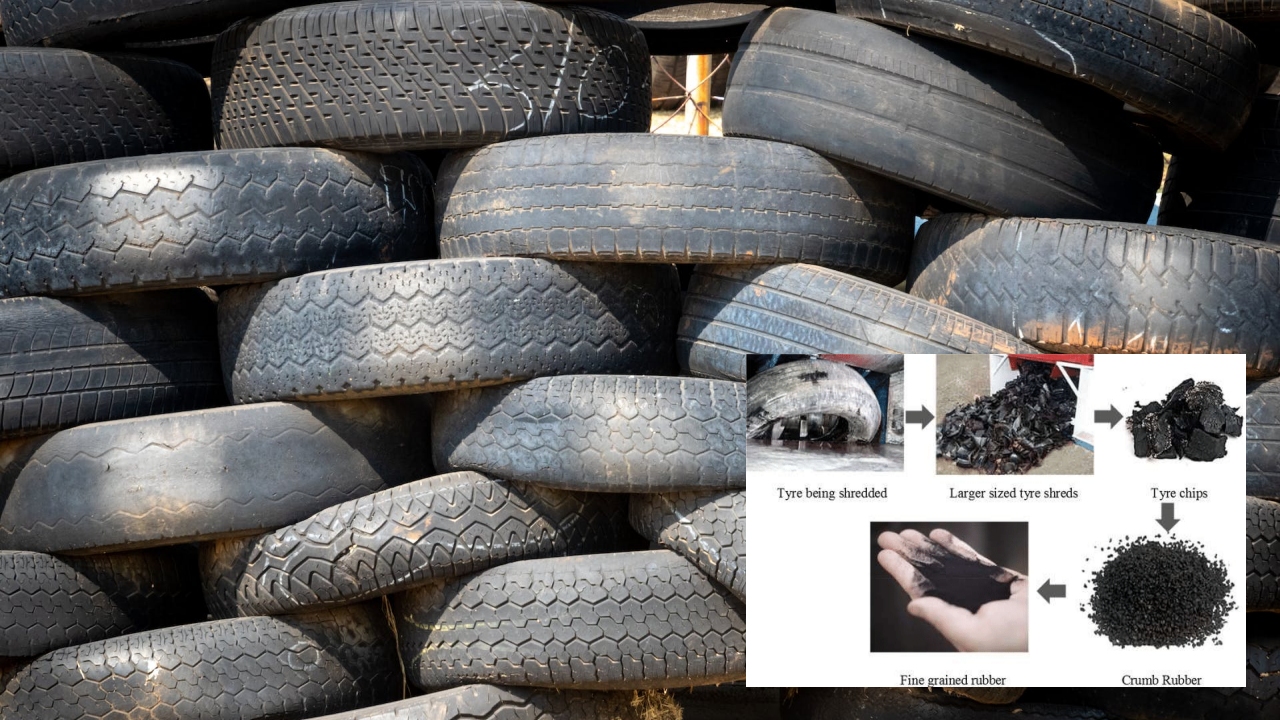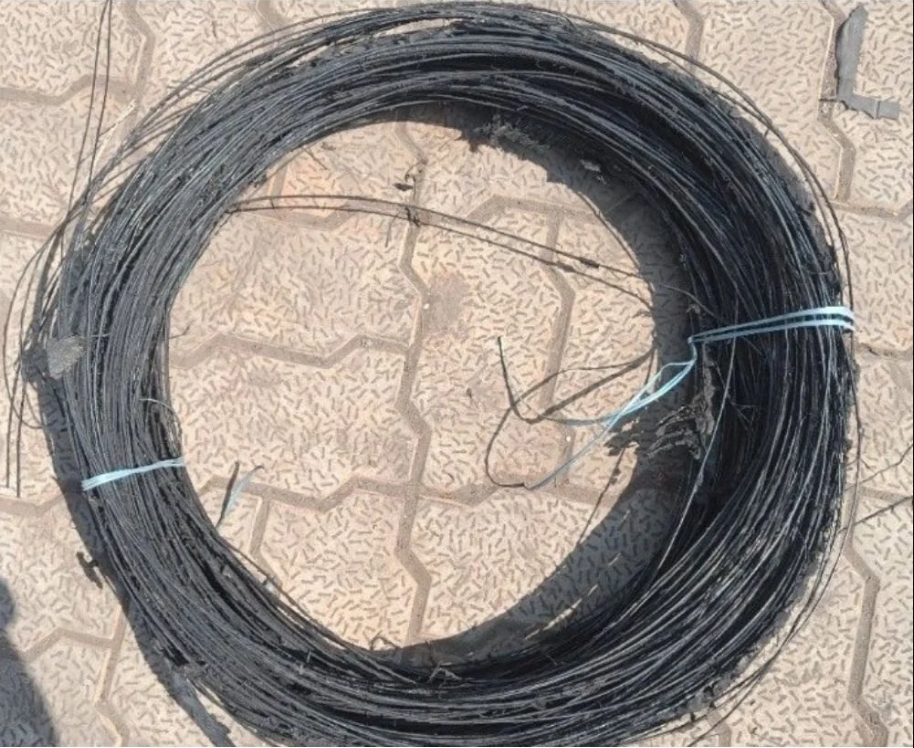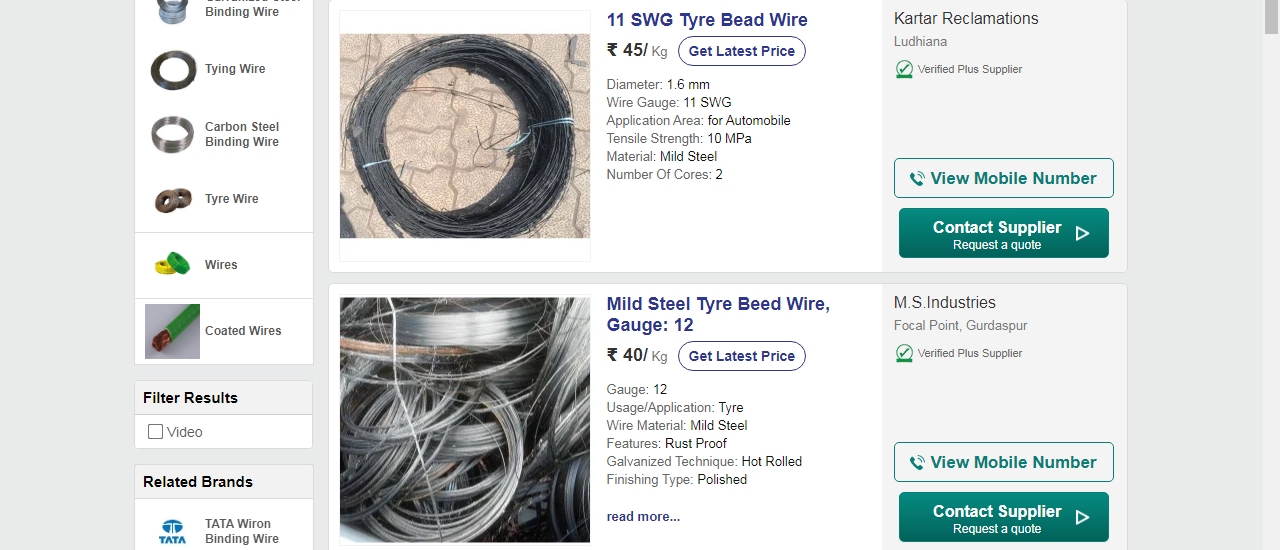Tyre-derived aggregate (TDA) and tyre-derived Fuel are the two main products derived from the tyre recycling process. We will mainly focus on tyre-derived aggregate both as marketing the rubber powder and crumb; such as for rubber surfaces such as artificial turfs or playgrounds surfaces, gym, driveways, shock-absorbent flooting, rubber mulch in the garden or processing it further such as moulding it into tiles, paving bricks, mats or rubber lumber.
Nomenclature
Tyre-derived aggregate: building material made of recycled tires, which are shredded into pieces of varying sizes.
Crumb rubber: recycled rubber produced from automotive and truck scrap tires. During the recycling process, steel and tire cord (fluff) are removed, leaving tire rubber with a granular consistency.
Rubberized asphalt: noise reducing pavement material that consists of regular asphalt concrete mixed with crumb rubber made from recycled tyres
Rubber mulch: a type of mulch used in gardens and landscaping that is made from recycled rubber, most often crumb rubber sourced from waste tyres.

Process
Overview
The shredder reduces these materials into smaller pieces (sometimes in two stages), while the granulator refines them into granules that can be used to create new plastic and rubber products.
The shredder rips the tyres into chunks, the crusher then crushes them into smaller pieces or granules. The remnants are raked over a vibrating screen while a dust extrator is working. The vibrating machines sifts the right sized smaller pieces and sends the bigger pieces through the crusher or granulator again. All the while a magnetic seperator machine pulls out remaining metal shards. The fiber is also seperated from the rubber. What is left is the granulated rubber product which is often sent through the virbrating screen again to seperate the smaller powder like with a softer feel(for surfaces) from the larger crumbs used in pavers (see below).
There is a optional starting phase of debeading a tyre to remove the wire and to remove the sidewall and to cut it into smaller pieces. There is a debate around the former based on the type of shredding machine and cutting the tyre into pieces before shredding adds another step to the process.
The full tyre recycling tyre crushing and separating line is more or less as follows:
Tyre Shredder Machine
The tyre shredding machine preprocesses the entire tire into large rubber pieces or chunks. E.g. Some shredders do 50-80mm chunks.
Steel Wire Separator Machine
The tyre chips were further processed (e.g. smaller 20mm chunks) into less than serrated knife of steel wires separator machine.
Magnetic Separator Machine
Removes the metal from the rubber using a conveyor belt with magnets
Granulator or Crusher machine
Takes the rubber chunks and granulates it into smaller particles say 2-7mm particles however this simply depends on what size screen is being used. The nylon and the fibers are also ofren removed here by a Dust Collection Machine.
Vibrating Screening Machine
Feeds the particles through a sieve to ensure its the right size. If not gets fed through granulator again.
The above is usually what a full line looks like, I will go into a smaller line soon. As with tyre retreading these can be purchased (imported) as a complete line but can also be assembled piecemeal. But what is important to note is that most of the above is not specific to tyre recycling. Only the shredder, granulator and wire remover. Magnetic seperators, virbrating machines, dust collection machines those are machines used in mining, manufacturing. So when assembling locally Techno Power can supply the magnetic seperator which they also supply to food mining etc. Same for vibrating screen machines mining suppliers like Flo-scan sell screen vibrators. Same with dust extractors.
Sourcing equipment
Firstly remember that we are dealing with intricate multi-million rand equipment that needs to be properly sourced otherwise you will have serious problems. In other words scope creep needs to be avoided and the equipment has to work.
Now there are strategies when sourcing equipment such as make sure your setup is modular, avoid combo machines if possible (slower than individual machines and if it breaks you have two problems rather than one).
When sourcing specialised equipment in South Africa you are unlikely to get a full line like you can order from China. Nor will get get a off-the-shelf machine unless they are ordering it from China.
I spoke to a local shredder manufacturer and I said I want to recycle passenger tyres and they had this to say:
All our machines are custom-built to customer requirements.
What I need to know is size and quantity of shred output so that we can determine the correct shredder.
This is the nature of a lot of local specialised machine manufacturers they only build custom.
Equipment
If you are looking for a tyre-specific local shredding or granulating equipment you can post a lead in the marketplace.
Making rubber pavers
The (around 3-5mm) rubber crumbs proved above are twirled inside heated mixers a polyurethane binder helps hold everything together. Dyes are added to change the colour, the rubber and polyurethane is added to the paver mould, put on trays and then compressed with an hydraulic press.
Sourcing tyres
Whenever I am sourcing waste I prefer direct collection from the source in this case such as fitment centers vs. a collection point such as a recycler that buys various waste and then you buy from them. While the latter allows for scale not everyone wants to buy in tyres. They don't know if they can sell it, we are dealing with big and bulky items that is just not worth it to transport very far. So you would need to make contacts. What you need to establish is what is the maximum amount of money that you can pay for a tyre. That includes the cost to get it to your door.
There is another way to source tyres via a government program called the "Waste Bureau division". I don't work with the government and only operate privately so I can't comment on how effective that is. The government's last tyre recycling program REDISA (Recycling and Economic Development Initiative of South Africa) Integrated Industry Waste Tyre Management Plan (IIWTMP) collapsed because of **checks notes** corruption and the businesses of those who depended on collapsed as well. Privately there are clear fundamentals, the air is clean. You hear words from government like "Waste Bureau", "Section 29 Integrated Waste Tyre Plan" and "Green Public Procurement" but what do they actually mean? And more importantly will they exist tomorrow? I can tell you that Tiger Wheel & Tyre will exist and so will Hi-Q, Supa Quick and the hundreds of other tyre dealers.
Selling
We have the raw material of rubber powder and crumb and we spoke of surfaces and pavers and mulch. Here is an example of the wide range of applications.
Product & Applications
Athletics Tracks
Building Insulation
Playground Surfaces
Brake Shoes
Matting Surfaces
Tarred Roads
Marine Non-Slip
New Tyre
Tile Adhesive
Sport Surfaces
 1 ton bag of tyre crumb
1 ton bag of tyre crumb
 Rubber crumb "dog bone" pavers
Rubber crumb "dog bone" pavers
 Crumb rubber tile
Crumb rubber tile
 Crumb rubber surface
Crumb rubber surface
Should you debead and cut tyres up
In the Nigerian video above there is two stages I do not mention:
They first remove the steel wires from the rubber using a tyre debeader (tyre bead is the term for the edge of a tire that sits on the rim)
Then it goes into a tyre cutting machine to cut the tyre into four or five pieces
That is a good example of a small business setup.
There is two school of thought some say de-beading is necessary because of excessive wear on the cutters while opinion among larger especially the tyre-derived fuel (PDF) operators is that process is labour intensive and not very safe:
"Do not debead
The inherently dangerous debeading process can also now be avoided.
A debeaded tyre has long been considered easier to shred, which explains why many TDF lines have traditionally incorporated a ‘hook’ which grabs the bead from the tyre to rip it out with brute force.
However, while this technique protects the machine from wear and possible damage, it adds to the plant’s labour intensiveness and level of risk that the operator is exposed to. Small, low power, dual shaft shredders would still struggle to handle a tyre’s bead, but larger, high torque, single shaft machines are now purposefully engineered to withstand the pressures of this tough, bulky waste stream".
This is a hook debeader and here is a good example why its not considered safe.
Debeading Business Opportunity

Tyre bead wire Kartar Reclamations
If you are able to connect with a fitment center or tyre recycler that does not have a beading machine. There is a business opportunity to do the beading in exchange for keeping the wire. There is over a kilogram of high carbon steel that can be sold as scrap to a recycler. This is why homeless people sometimes burn tyres to get to the beading wire which is a billion dollar industry.
The question is can you find someone to work with, will they let you put your machine in their premises, how many tyres can you debead a day. If you getting R2 for the wire in each tyre and you can do 1000 tyres a day its not a bad single person business. But that number of tyres is probably unrealisticly high so you might need to look at getting higher than scrap value for the beading wire. In India they sell reclaimed wire for around 40-45 rupees per kg (around R9). If you can get close to that by maybe supplying companies who make springs or screen net. This is the cheapest to enter this stream as a debeaning machine can be picked up for less than R100k

 Tyre bead wire suppliers ©Indiamart
Tyre bead wire suppliers ©Indiamart
Check this debeader out far safer than the brute force machine. Only issue is you have to remove the sidewalls which is laborious:
I have gone over the capital intensive expenditure above the next main thing is sourcing the tyres and selling the raw material.
 End-of-life / Waste / Scrap Tyres
End-of-life / Waste / Scrap Tyres
 Tyre Shredding
Tyre Shredding
 Rubber crumb
Rubber crumb

